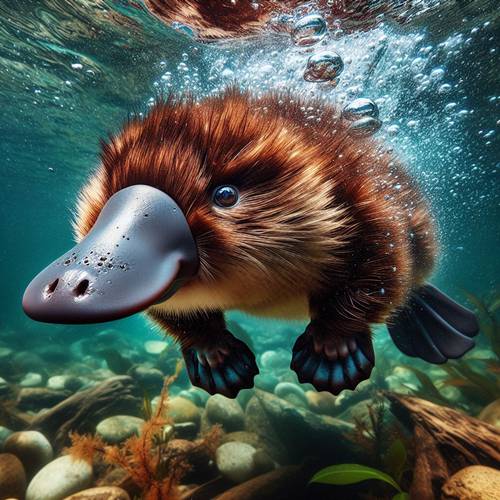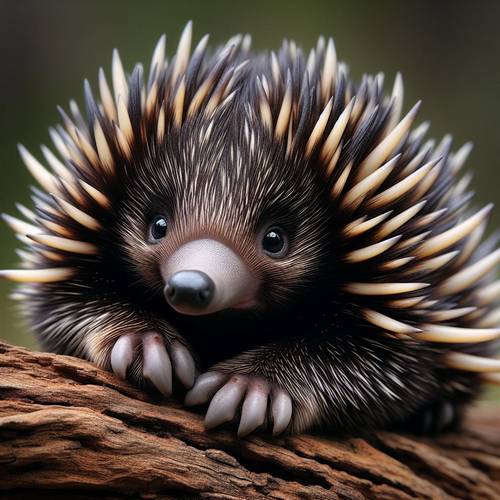A Blend of Strange and Wonderful: Platypus Features

The platypus (Ornithorhynchus anatinus) is a unique mammal that defies easy classification. It lays eggs, has a duck-like bill, webbed feet, and a beaver-like tail. This bizarre combination has made it a fascinating subject of scientific study for centuries.
The platypus's bill is its most distinctive feature. Covered in electroreceptors, it allows the platypus to detect the electrical fields of its prey in murky water. It's also used for digging and grooming.
The platypus's webbed feet are perfect for swimming, but on land, it walks on its claws, with the webs folding back for better grip. Male platypuses have venomous spurs on their hind legs, used for defense during mating season.
The platypus's dense, water-repellent fur provides insulation in cold water and keeps it dry on land. This remarkable creature is a testament to the diversity and wonder of the natural world.
The platypus's bill is its most distinctive feature. Covered in electroreceptors, it allows the platypus to detect the electrical fields of its prey in murky water. It's also used for digging and grooming.
The platypus's webbed feet are perfect for swimming, but on land, it walks on its claws, with the webs folding back for better grip. Male platypuses have venomous spurs on their hind legs, used for defense during mating season.
The platypus's dense, water-repellent fur provides insulation in cold water and keeps it dry on land. This remarkable creature is a testament to the diversity and wonder of the natural world.
A Unique Reproduction: The Platypus's Egg-laying Process
Ever heard of a mammal that lays eggs? Yeah, me neither... until I met the platypus. This little guy is like a nature riddle, all mixed up and fascinating. It's got a duck bill, webbed feet, a beaver tail, and… it lays eggs? Yep, that's the platypus's secret superpower.
Why is this weird, you ask? Well, mammals are supposed to give birth to live babies. Think of a dog, a cat, a human – they all have live babies. But the platypus? It's like nature went, "Let's shake things up!" and threw in some reptilian traits for good measure.
So, how does this egg-laying thing work?
• First, there's the burrow: The platypus is a master digger, building burrows in the riverbanks with a secret chamber for the eggs. It's like a cozy little nest for the future babies.
• Then, the eggs: The mama platypus lays 1-3 leathery eggs, kind of like small, round, white beans. They're not like the hard-shelled eggs you find in the grocery store. These are soft and flexible.
• Incubation time: The mama stays in her burrow and keeps those eggs warm and safe for about 10 days. Think of her as a built-in incubator.
• Hatchlings arrive: And then... boom! Baby platypuses, called "puggles," hatch out. They're tiny and blind, just like baby birds.
• Mama's Milk Bar: The mama platypus doesn't have nipples, so she produces milk from special glands on her belly. The puggles lick up the milk, which is super nutritious and helps them grow fast.
The platypus is like a walking "What If?" question from nature. It's a reminder that the natural world is full of surprises, and sometimes the most unexpected creatures are the most fascinating.
Next time you're thinking about the weird and wonderful things nature does, remember the platypus. This little egg-laying mammal is proof that nature doesn't play by our rules, and that's what makes it so amazing.
Why is this weird, you ask? Well, mammals are supposed to give birth to live babies. Think of a dog, a cat, a human – they all have live babies. But the platypus? It's like nature went, "Let's shake things up!" and threw in some reptilian traits for good measure.
So, how does this egg-laying thing work?
• First, there's the burrow: The platypus is a master digger, building burrows in the riverbanks with a secret chamber for the eggs. It's like a cozy little nest for the future babies.
• Then, the eggs: The mama platypus lays 1-3 leathery eggs, kind of like small, round, white beans. They're not like the hard-shelled eggs you find in the grocery store. These are soft and flexible.
• Incubation time: The mama stays in her burrow and keeps those eggs warm and safe for about 10 days. Think of her as a built-in incubator.
• Hatchlings arrive: And then... boom! Baby platypuses, called "puggles," hatch out. They're tiny and blind, just like baby birds.
• Mama's Milk Bar: The mama platypus doesn't have nipples, so she produces milk from special glands on her belly. The puggles lick up the milk, which is super nutritious and helps them grow fast.
The platypus is like a walking "What If?" question from nature. It's a reminder that the natural world is full of surprises, and sometimes the most unexpected creatures are the most fascinating.
Next time you're thinking about the weird and wonderful things nature does, remember the platypus. This little egg-laying mammal is proof that nature doesn't play by our rules, and that's what makes it so amazing.


